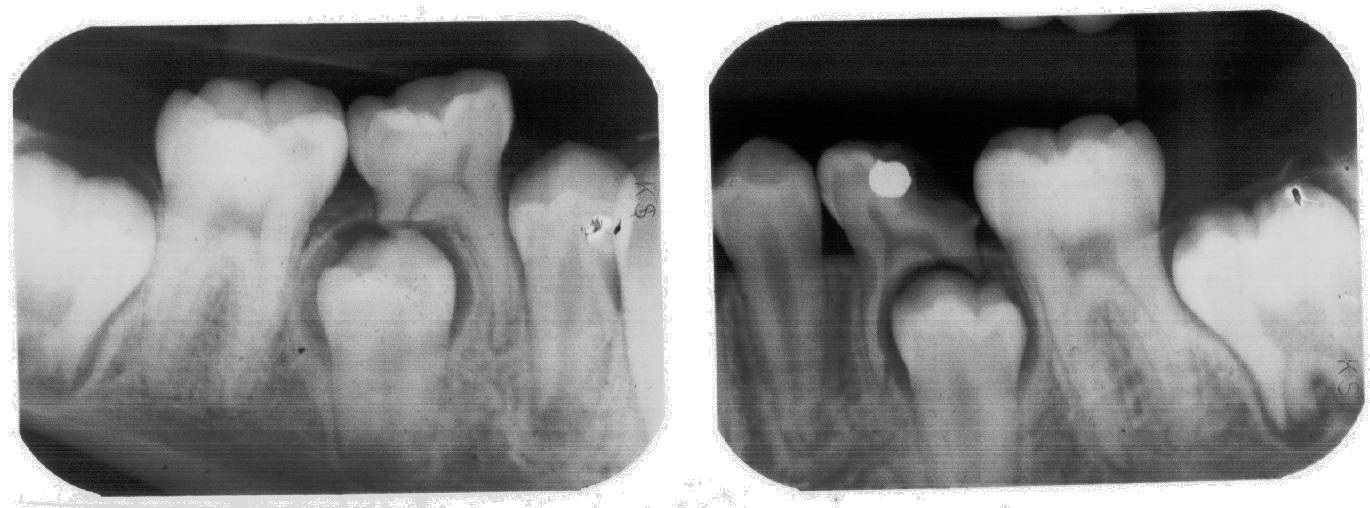
Scanning X-Ray Films
Dealing With The X-Ray Films
Warning — This is the page where it will
be most obvious that I am an electrical engineer
and not a radiologist or a dentist.
There are two main X-ray film types to deal with —
a small intraoral ("inside the mouth") film,
40x30 mm.
and a large extraoral ("outside the mouth") film,
280x125 mm.
The films are used in various ways.
The intraoral film might be used for a periapical
("around the (root) tip") view capturing the root tip,
or a "bitewing" view capturing the crowns and the
alveolar bone and its loss.
The relatively small film is held inside the mouth and the
X-ray source positioned outside, the difference between
periapical and bitewing coming down to film placement
and X-ray illumination direction.
"Bitewing" films are named for the wing-shaped
tab the patient bites to hold the film in place.
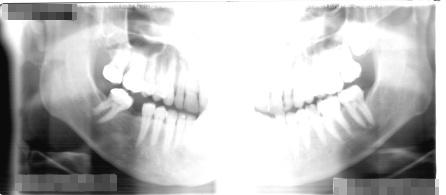
One 280x125 mm film exposed in a Pan-O-Rex brand system.
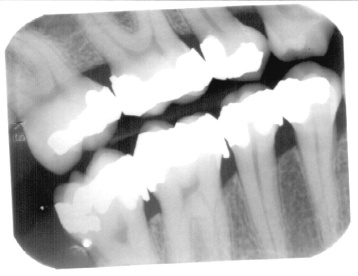
One 40x30 mm film. Most have rounded corners like this.
However, as far as scanning goes, periapical and bitewing have the same characteristics of density average and variation. There is a great deal of variation within the set of periapical films, and a great deal of variation within the set of bitewing films. Any systematic difference between the categories of periapical and bitewing films is overwhelmed by the huge variation within those categories.
The much larger 280x125 mm film is used for panoramic imaging. The patient typically sits in a special chair with their chin in a cup-like holder. An arm holds the X-ray source on one side of their head, and on the opposite site, the large film moves behind a slit in a shielded panel. The arm swings around their head, and in some system designs, the chair may translate slightly to the side at the half-way point.
The result is a panoramic view of the entire mouth and surrounding structures. Depending on the system design, there may be a blank region in the center where the system avoided attempting to image through the spinal column. That part of the film is unexposed, so it's clear. It looks "washed out" to me, especially since that central unexposed area has an indistinct boundary.
Notice how the plastic sleeve design varies. The one at lower left in the first picture below would be the best one for scanning purposes, as it keeps the individual films relatively close together. The background outside the sleeve could easily be masked off and give us a scan with a relatively small fraction of bare backlit background.
But then look at the sleeves at upper left and lower right and see how they leave more space between the films. Those films are slightly misaligned with respect to each other.
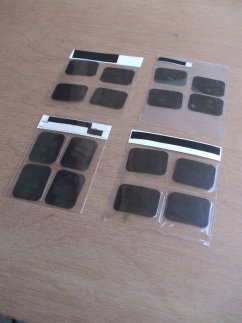
Four sleeves of four 40x30 mm films each. Notice the varying sleeve design, film layout, presence and shape of paper labels.

Three 280x125 mm extraoral films.
I discovered a number of data collection rules:
All 40x30 mm films must be left within their sleeves. The archival information (name, date) is written on the sleeves. Films spread out on a table are easily mixed and confused. There is nothing on a film itself to identify it, unless you find some features identical to those on another film still safely nestled in its labeled sleeve.
Films cannot be realigned within their sleeves. Remember the older sleeve that had started to react with its films. Also see the staining on the sleeve at left. The stain pattern corresponds to the fully saturated areas of the film. It is clearly a chemical reaction between the film and the plastic sleeve.
It is not practical to create detailed masking for individual films or sleeves. I made some test scans of sleeves where I had cut black plastic electrical tape into narrow strips, blocking almost all the surface except that of the films themselves. That produced very high quality data, but it is much too labor intensive. Unless you are just scanning a few films, you really have to deal with the film sleeves as complete units.
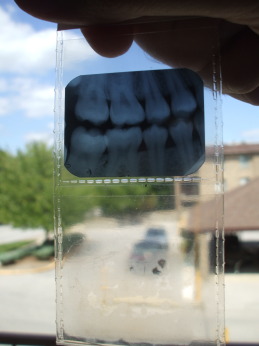
A film was removed from the lower pocket in this plastic sleeve, leaving a cloudy stain where the film and the sleeve had reacted.
The sleeves come in rolls, two pockets high. You can cut or tear them off at any length. 1x2, 2x2, 3x2, and 4x2 sleeves are all common. Some sleeves hold an odd number of films, meaning an empty pocket and a large increase in the bare background proportion of the scanned image.
The solution to the masking problem is to cut thin cardboard into useful rectangular shapes. I used a cereal box. You will need a few pieces roughly the size of one film pocket to block those empty pockets. Other pieces of varying size will be used to block the regions of the glass not used when you scan a collection of films.
In order to keep track of which scanned images correspond to which patients, you may find that this problem partly solves itself. The labels on the sleeves, either paper stickers, slips of thin cardstock, or plastic, tend to be translucent enough at the light levels used that writing on them is legible in the scanned image. You can also write with a Sharpie type pen on a slip of paper and place that on the scanner with a collection of films. The paper will be translucent enough that the thick dark Sharpie writing is easily read.
What about film grain size, or resolution?
What scanner settings should be used to capture all available information without wasting collection time and storage space? What is the grain size of the film, which will define its resolution or the limit on the size of visible details?
I looked around the Kodak web site, specifically in the dental X-ray film area, but I could find no information.
Then I was given the telephone number for Kodak's dental customer service operation. This was a specialized office dealing just with their dental X-ray film products. They were the people to ask any technical question about Kodak X-ray film.
I asked the Kodak technical representative, "What is the grain size of your DF-58 intraoral X-ray film?
The Kodak technical representative not only didn't know the answer to my question, he didn't even know what film grain size was.
OK, this is surely my fault, I shouldn't have been sloppy and used the term "film grain size". So, I asked about resolution.
Still no clue to the answer or even to the meaning of my question.
"Well, you see, I need to know the size of the smallest visible feature in a developed X-ray film. There will be some lower limit to visible feature size based on the graininess of the film chemistry. What is that? And if you don't know, could I speak to someone who does know?"
According to what I was told by the Kodak technical representative, no one at Kodak knows what the grain size is for their dental X-ray film. They don't even know what "grain size" might be. But, he cheerily added, I should look at a specific web page on the Kodak web site because that is where everything is!
I dutifully wrote down the URL
while fighting the urge to ask the phone drone how that
magical web page got created when no one working for
the company knows the information supposedly stored there.
I looked, and the information on that web page was limited to:
➊ Kodak film is very very good and I should buy some!
➋ Kodak film comes in bright yellow-orange boxes!
➌ Kodak thinks that their film is the best,
and I should, too!
Meanwhile the Fuji dental X-ray film pages are cluttered with all sorts of useful information, including film grain size.
Since Kodak was completely unhelpful, I managed to estimate on my own that their DF-58 intraoral film has a grain size of around 0.085-0.13 millimeters. I did this by scanning a representative sampling of films at the finest resolution of the scanner, 1200 ppi or 47.2 points per mm. I placed the films on the scanner's glass plate, and then laid a piece of glass on top of them to prevent any film motion between scans. I then took multiple scans at varying illumination levels.
The images were therefore registered to one another, meaning that the pixel at some row and column in one image should correspond to the same point on the film as the pixels at the same row and column location in the other images. Those pixels should be of the same point on the films, as long as the scanner carriage's motion was exactly the same from one scan to the next. It was not exact but very close, within two or three pixels. I was impressed with the precision of my US$ 7.50 instrument.
The resulting images were quite large, so I extracted subimages from high-detail areas of the different films, typically a small region around the neck of a tooth showing its enamel, its dentin, and some of the surrounding alveolar bone. This region would be no more than about 450 pixels on a side, meaning a region less than 1 centimeter wide on the film. Those were then displayed at twice their size on the screen.
Comparing these subimages by flipping back and forth in the sequence, you can see that there is a slight graininess in areas otherwise of constant medium grey level. And, this graininess is consistent from one image to the next — it is a feature of the film and not sensor noise. I found that the smallest grain features constant from one image to the next were between 4 and 6 pixels across when scanned at 1200 pixels per inch. The visible structural details of the teeth and bones were all larger than this grain size.

Film grain pattern in a small area of Kodak DF-58 film. This image spans just one molar at the top of its roots. Scanned at 1200 pixels per inch, this 517×159 pixel image corresponds to just 0.431×0.133 inches or 10.94×3.37 mm.
4 to 6 pixels at 1200 ppi means that the grains are 1/300 to 1/200 of an inch across, or 0.084667 to 0.127 millimeters. So, scans at 400 ppi (15.75 points per millimeter) should measure at least one point within each film grain, and therefore capture all the information available in the mysterious Kodak DF-58 film.
The large panoramic films can be scanned at lower resolution without noticeably losing information. Lower resolution scans allow the scanner to run faster, although I noticed a non-linear relationship for the time required for a scan of the full scanning area:
| Resolution | Time |
| 100 ppi | 40 seconds |
| 200 ppi | 60 seconds |
| 300 ppi | 61 seconds |
| 400 ppi | 107 seconds |
See Grzegorz Jezierski's on-line collection of X-ray tubes for lots of pictures and the history behind the devices.
Conventional photographers might wonder why this film is so large grained. It's to reduce the needed X-ray exposure.
As films have gotten faster (and larger grained), the X-ray exposures have gotten shorter and shorter.
No more extra high dose imaging as with the systems at the Walter Reed Army Hospital's museum of medical history, where you can also see iron lungs, Abe Lincoln's skull fragments, and more.
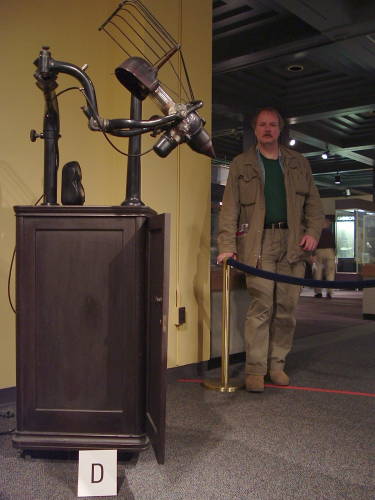
Me with a 1923 Ritter dental X-ray machine, at the Walter Reed museum of medical history.
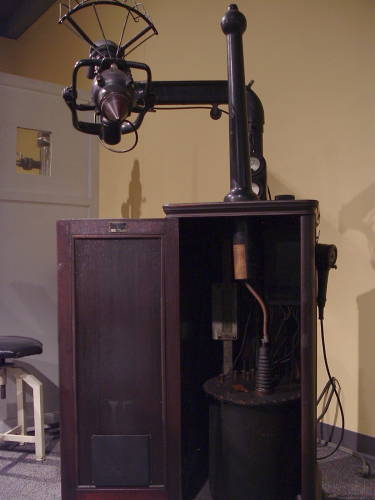
Interior of the 1923 Ritter dental X-ray machine, showing the large high-voltage transformer.
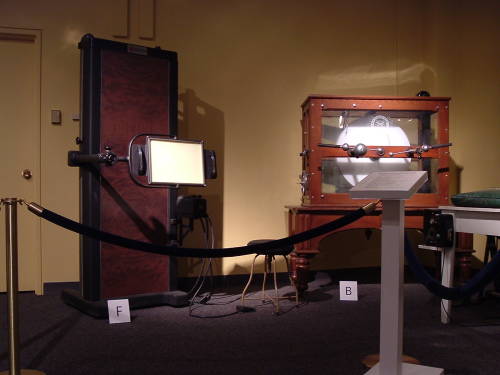
At left, a full-body fluoroscope from maybe the 1940s.
I've only seen these used in Warner Brothers cartoons.
At right is a Wimshurst machine for generating
high voltage.
What about film density?
The density of the film, the measure of how much incident light will pass through a point on the film, is certainly important. If I were designing a complete system from scratch, I would want to take this into account. However, since I am cobbling this together from an existing low-cost scanner, there doesn't seem to be much I can really do about this. The AGC (automatic gain control) effects of the scanner hardware and the scanner driving software will hide the true film density from me, in an attempt to make the original scanner design relatively easy to use. A later page discusses light box and software settings to deal with varying film density.
Thanks to a suggestion from someone who read these pages, you might want to see the Non-Destructive Testing / Non-Destructive Evaluation Center's educational material on radiographic testing, and especially their page on radiographic film density.
Now you're ready for the next step: learning how to use the XSane scanning software